Fragmentation in Operating System Explained
Updated on : 21 MAY 2025
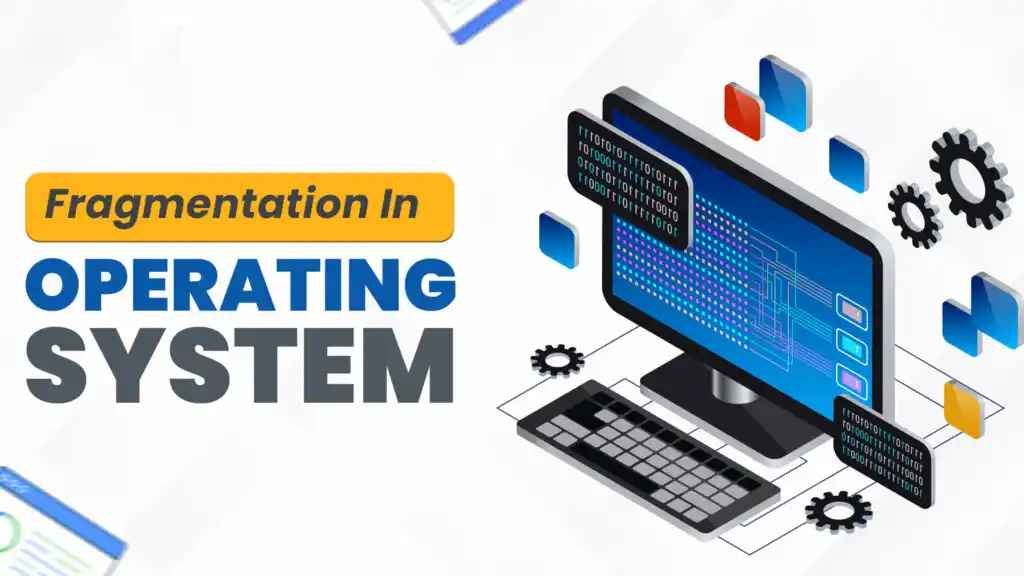
Image Source: google.com
Table Of Contents
- 1. Introduction
- 2. What is Fragmentation
- 3. Fragmentation Types in Operating Systems
- 4. External Fragmentation Overview
- 5. Internal Fragmentation Overview
- 6. Fragmentation's Role in Operating Systems
- 7. Solutions for Fragmentation in Operating Systems
- 8. Managing Memory Fragmentation
- 9. Using Paging to Address Fragmentation
- 10. Implementing Segmentation to Reduce Fragmentation
- 11. Applying Paging with Virtual Memory
- 12. Exploring Buddy System for Memory Allocation
- 13. FAQs
Table Of Contents
Introduction
Fragmentation in Operating System Explained: Imagine your memory as a big puzzle, but pieces get scattered and small gaps appear. This is fragmentation, making it tough to fit big programs smoothly. Fragmentation in Operating System Explained shows why managing these gaps is key to keeping your system fast and efficient!
What is Fragmentation
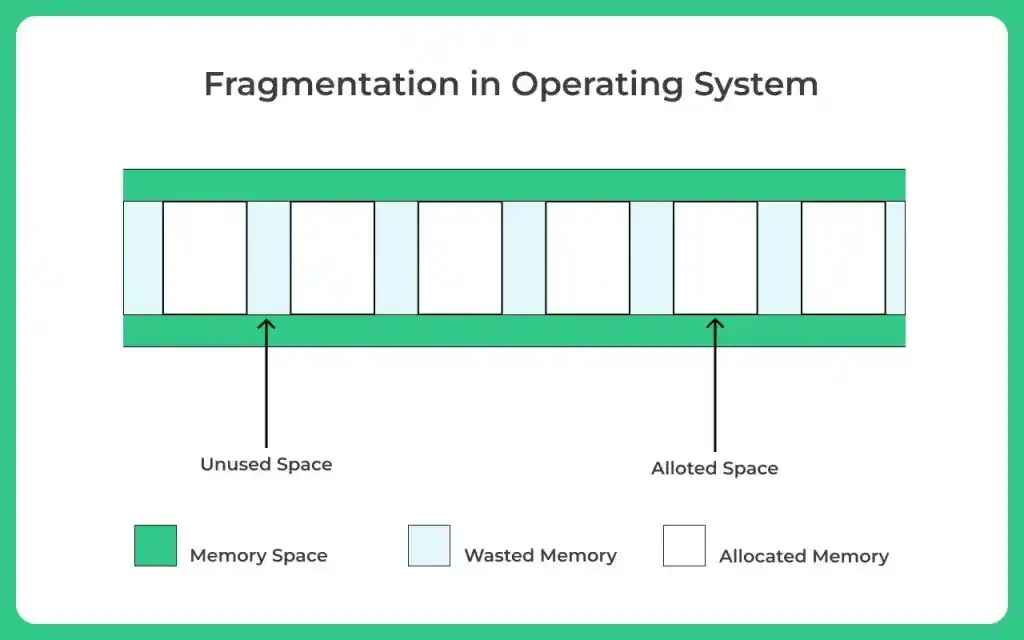
Image Source: google
Fragmentation happens when memory is broken into small pieces, making it hard to use efficiently.
What is Fragmentation in OS? 🤔
- Memory gets split into tiny chunks.
- These chunks may not be next to each other.
- It causes problems when trying to store big data or programs.
Why is Fragmentation a Problem? ⚠️
- Memory is wasted or inefficient.
- Programs may fail to run even if enough total memory is free.
- System performance can slow down.
Summary 📋
- Fragmentation = memory split into small unusable parts.
- Two types: external (scattered free space) and internal (wasted space inside blocks).
- Causes inefficient memory use and slows systems.
Fragmentation Types in Operating Systems
| 🔍 Fragmentation Type | 📋 Description |
|---|---|
| External Fragmentation 🌌 | Free memory split into small scattered blocks; enough total memory but not contiguous. |
| Internal Fragmentation 🕳️ | Allocated memory block is larger than requested, wasting space inside the block. |
External Fragmentation Overview
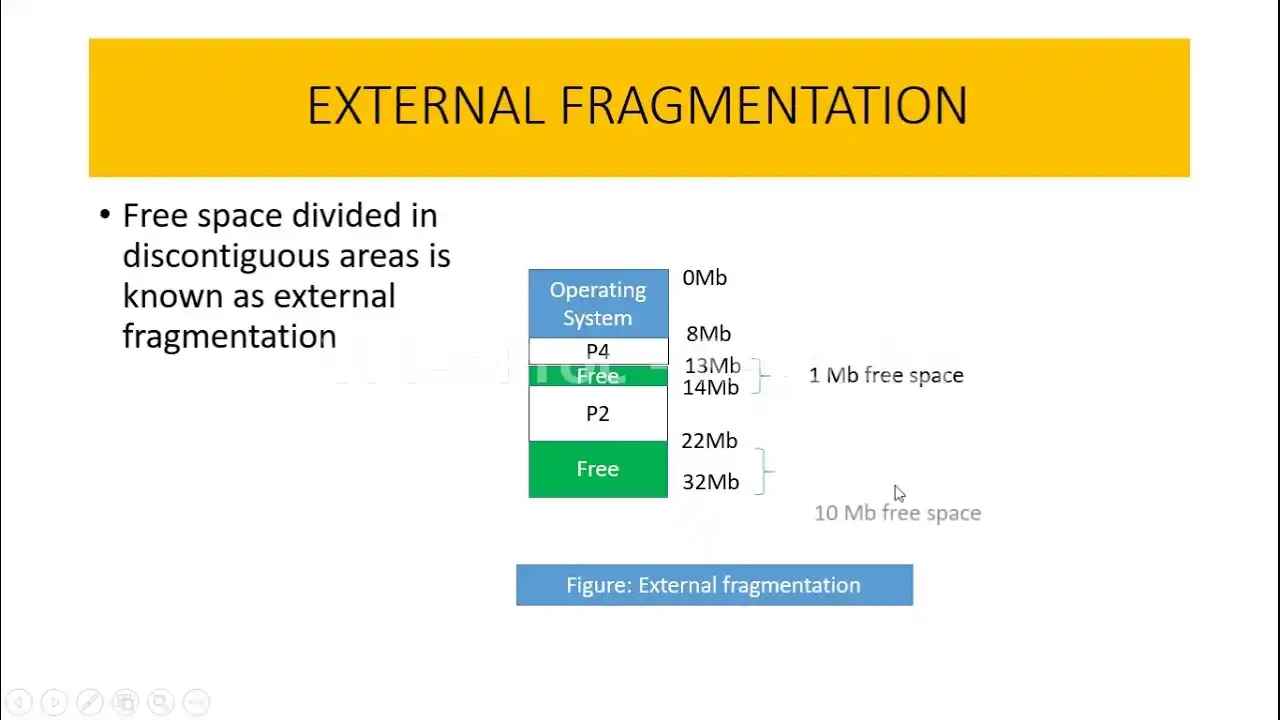
Image Source: google
Fragmentation in Operating System Explained refers to memory being broken into unusable parts. One common type is External Fragmentation.
🔹 What is External Fragmentation?
- Happens when free memory is broken into small, non-contiguous blocks.
- Even with enough total free space, memory can't be allocated because it's not in one continuous block.
🔹 Causes
- Occurs in systems with dynamic memory allocation.
- Happens over time as processes are loaded and removed.
🔹 Effects
- Wastes usable memory.
- Slows down the system.
- Can prevent large programs from loading.
🔹 Solution
- Compaction: Rearranging memory to combine free blocks.
- Paging/Segmentation: Avoids external fragmentation by not requiring contiguous blocks.
✅ This is a key concept under Fragmentation in Operating System Explained, helping us understand memory inefficiencies.

you want to hire SQL Developer?
Internal Fragmentation Overview
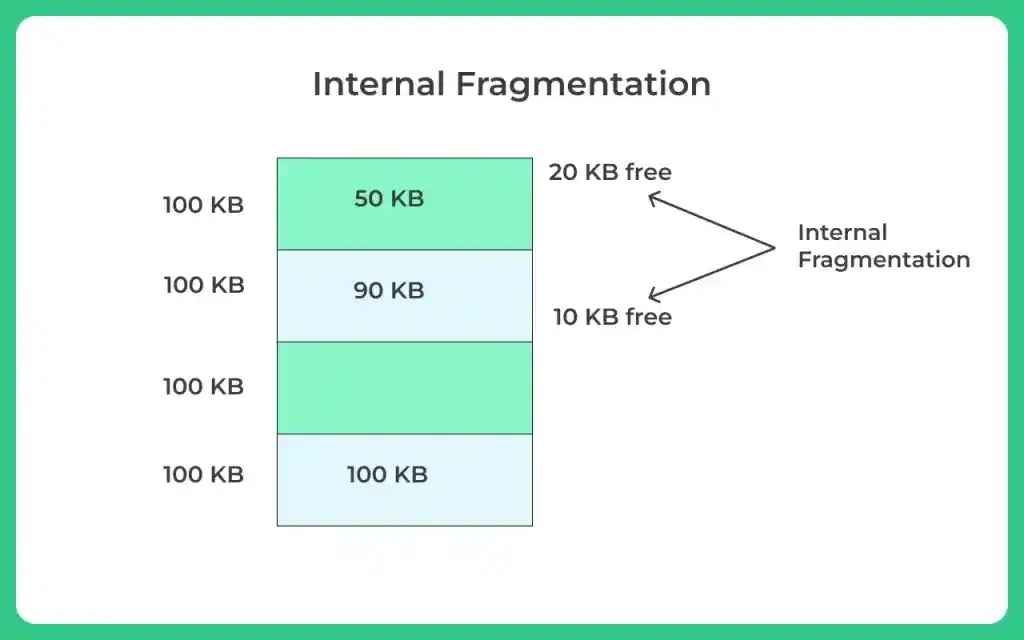
Image Source: google
Fragmentation in Operating System Explained refers to the inefficient use of memory. One common type is Internal Fragmentation, which happens when allocated memory is more than what is actually needed.
🔑 Key Points:
-
What is it? Extra memory is given to a process, but it doesn’t use all of it — the unused part is wasted.
-
When does it occur? Happens in systems with fixed-size memory blocks or partitions.
-
Example: If a process needs 18 KB, but the system allocates 20 KB, then 2 KB is wasted.
-
Impact: • Wastes valuable memory • Reduces overall system efficiency
-
Solution: • Use dynamic memory allocation • Minimize block sizes to reduce unused space
This is a key part of Fragmentation in Operating System Explained, helping you understand how memory inefficiency affects performance.
Fragmentation's Role in Operating Systems
| 🧩 Role | 📋 Description |
|---|---|
| Memory Utilization | Fragmentation affects how efficiently memory is used by breaking it into unusable parts. |
| System Performance | Excessive fragmentation can slow down the system and affect application execution. |
| Allocation Issues | Even with enough total memory, fragmentation can prevent allocating large blocks. |
| Need for Management | OS must manage and reduce fragmentation using techniques like paging, segmentation, or compaction. |
You Might Also Like
Solutions for Fragmentation in Operating Systems
| 🛠️ Solution | 📋 Description |
|---|---|
| Compaction | Rearranges memory to combine scattered free spaces into one large block (used for external fragmentation). |
| Paging | Divides memory into fixed-size pages; avoids external fragmentation completely. |
| Segmentation | Divides memory into logical segments (like code, data); helps manage memory more efficiently. |
| Dynamic Allocation | Allocates memory exactly as needed; reduces internal fragmentation. |
| Best-Fit / First-Fit | Allocation strategies to minimize leftover memory and reduce fragmentation. |
Managing Memory Fragmentation
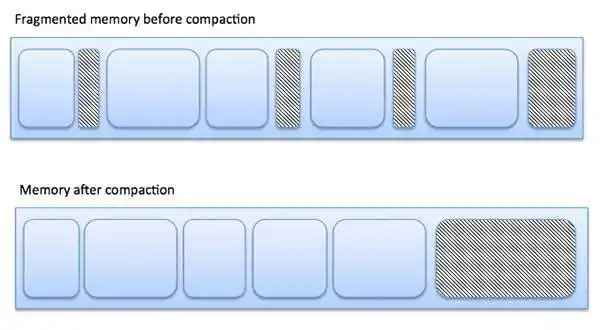
Image Source: google
| 🧠 Strategy | 📋 Description |
|---|---|
| Memory Compaction | Shifts processes to one side of memory to create a large block of free space. |
| Paging | Splits memory into fixed-size pages to avoid external fragmentation. |
| Segmentation | Divides memory into logical units (segments), improving organization and flexibility. |
| Dynamic Memory Allocation | Allocates memory based on exact needs to reduce internal fragmentation. |
| Efficient Allocation Algorithms | Uses best-fit, first-fit, or worst-fit strategies to minimize wasted space. |
Using Paging to Address Fragmentation
Fragmentation in Operating System Explained includes understanding how paging helps reduce memory waste. Paging is a memory management technique that avoids external fragmentation.
🔑 Key Points:
-
What is Paging? Memory is divided into fixed-size blocks called pages (in RAM) and frames (in physical memory).
-
How it works: • Processes are split into pages. • Pages are loaded into any available memory frame, no need for continuous space.
-
Benefits: • Eliminates external fragmentation 🧹 • Makes memory allocation flexible and efficient • Simplifies process management for the OS
-
Limitation: • Can still cause internal fragmentation if the last page has unused space.
Paging is a key technique in Fragmentation in Operating System Explained, helping operating systems manage memory more efficiently and reliably.
Implementing Segmentation to Reduce Fragmentation
| 🧩 Segmentation Concept | 📋 Description |
|---|---|
| What is Segmentation? | Memory is divided into logical segments like code, data, and stack. |
| Flexible Allocation | Each segment is allocated memory based on its size, reducing internal fragmentation. |
| Logical Organization | Segments reflect program structure, making it easier for the OS to manage memory. |
| Reduces Fragmentation | Helps minimize both internal and external fragmentation by allocating memory as needed. |
| Used in OS | Segmentation is often combined with paging for efficient memory management. |

Looking mySQL Developer For your business?
Applying Paging with Virtual Memory
| 🧠 Concept | 📋 Description |
|---|---|
| Paging | Divides physical memory into fixed-size frames and processes into pages. |
| Virtual Memory | Allows execution of processes larger than physical memory by using disk space. |
| Page Table | Maps virtual page numbers to physical frame numbers. |
| No External Fragmentation | Paging ensures free memory doesn’t need to be contiguous. |
| Efficient Memory Use | Only needed pages are loaded into memory, improving performance. |
Exploring Buddy System for Memory Allocation
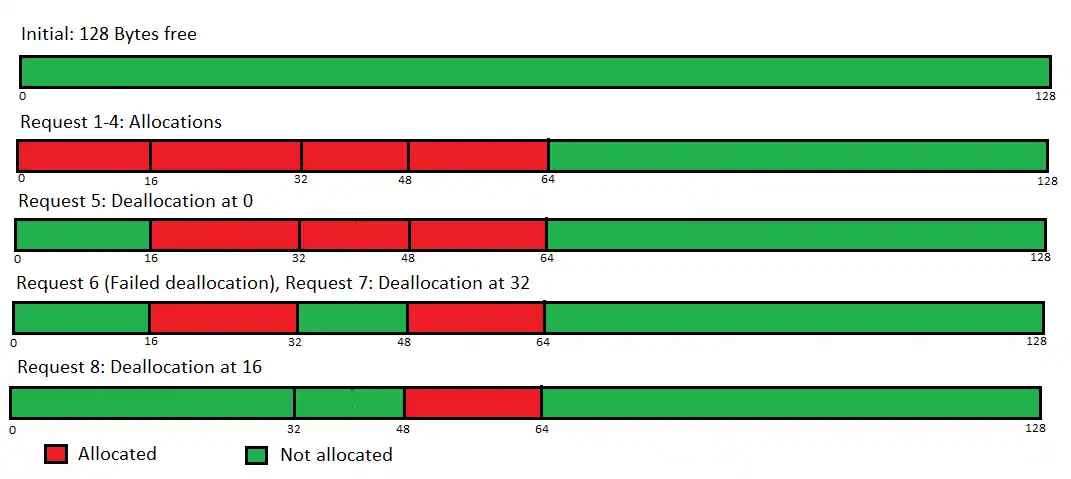
Image Source: google
The Buddy System is a memory allocation technique that helps manage memory efficiently and reduce fragmentation.
🔑 Key Points:
-
How It Works: • Memory is divided into blocks of sizes that are powers of 2 (e.g., 4 KB, 8 KB, 16 KB). • When a request comes, the system finds the smallest suitable block. • If a larger block is used, it splits into two “buddies” of equal size.
-
Merging Buddies: • When memory is freed, the system checks if the buddy block is also free. • If both buddies are free, they are merged to form a larger block. • This helps in reducing external fragmentation.
-
Advantages: • Fast allocation and deallocation. • Easy to manage. • Helps in minimizing Fragmentation in Operating System Explained.
-
Disadvantages: • Can still cause internal fragmentation due to fixed block sizes. • Slightly more complex logic than simple allocation methods.
In short, the Buddy System is an effective strategy under the topic Fragmentation in Operating System Explained for optimizing memory usage. Let me know if you'd like a table version too!
FAQs
Q.1. What is fragmentation in an operating system?
A : Fragmentation is when free memory is broken into small, scattered pieces, making it hard to allocate large contiguous blocks.
Q.2. What are the types of fragmentation?
A : External fragmentation Free memory is split into small scattered blocks.A : Internal fragmentation Allocated memory block is bigger than what is needed, wasting space inside.Q.3. Why is fragmentation a problem?
A : It wastes memory, causes inefficient use of space, and can slow down system performance.
Q.4. How can fragmentation be reduced?
A : By using techniques like compaction, paging, segmentation, and efficient memory allocation strategies.
Q.5. What is internal fragmentation?
A : It happens when allocated memory blocks are larger than the requested size, leaving unused space inside.
Q6: What is external fragmentation?
A : It occurs when free memory is available but scattered in small chunks, not in one large contiguous block.
Q.7. What is compaction?
A : Compaction is a technique to rearrange memory contents to combine free memory into a single contiguous block.





